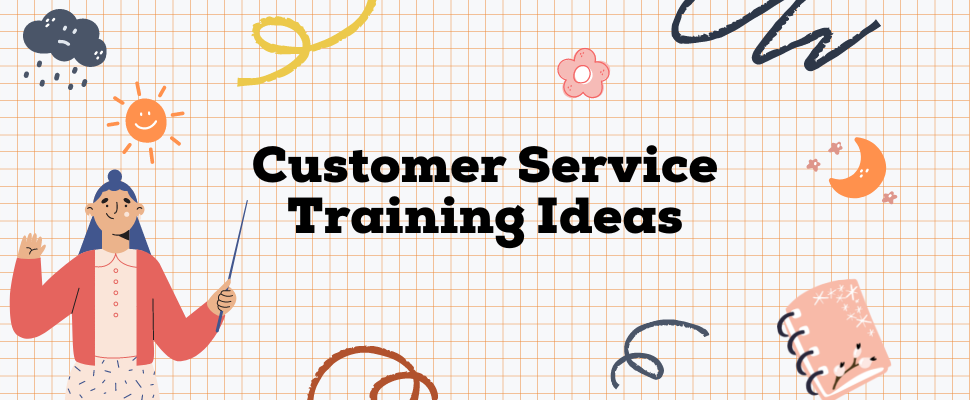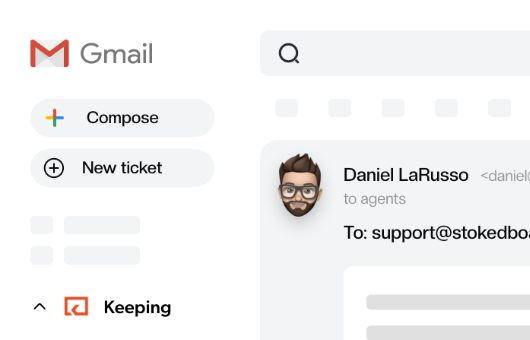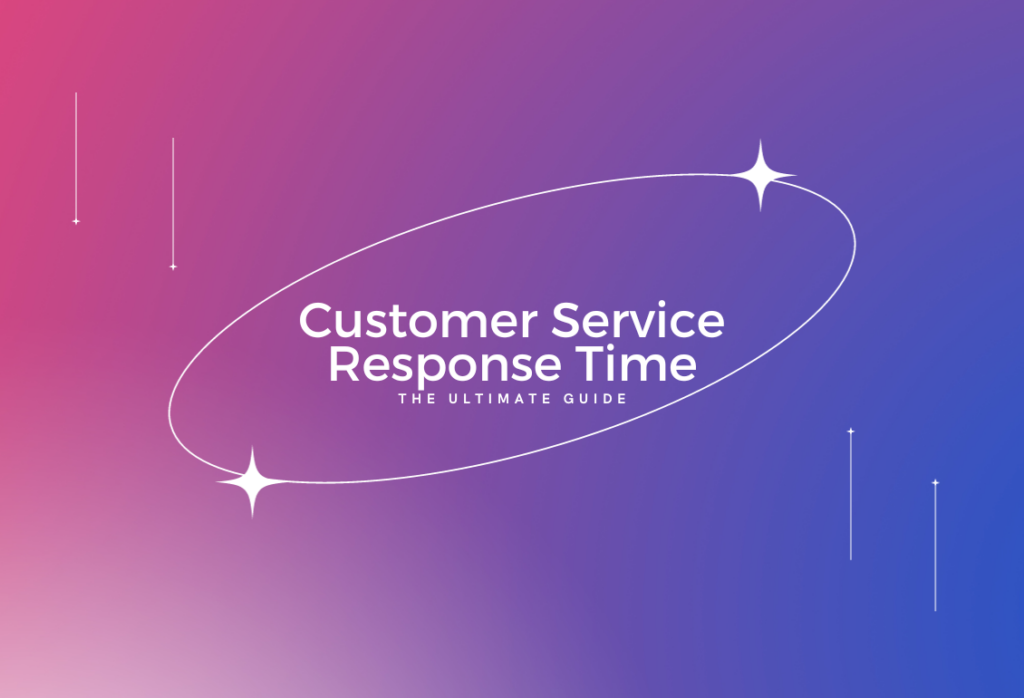
16 Customer Service Training Ideas for Your Team
Choosing the right training program is not easy, but you’ll want to focus on a mixture of hard and soft skills to ensure your agents are well-rounded. These customer service training ideas should help you achieve your goals.
All too often companies fail to invest in a high standard of customer service. They intensely focus on the acquisition of new customers at the expense of retaining the customers they already have. And when customers have lackluster service experiences, this results in unhappiness and negative reviews of your brand.
Customers who are unhappy won’t stick around, which is detrimental when you consider that 65% of a company’s business comes from existing customers.
Customer service teams are a big part of the success of any business. How you treat a customer after the sale can often be the make-or-break of whether that customer will bring you repeat business, and determines whether they will become loyal to your brand.
In order to remain competitive and keep delivering exceptional customer service, teams need to undergo regular customer service training. Customer service skills and knowledge need to be continuously updated or customer service reps will start falling behind.
The importance of customer service training
Happy employees equal happy customers. When your customer service agents are competent and confident, the standard of service rises and customers rate your business more positively. When customer service reps are well-trained and equipped to deal with a wide variety of customer scenarios, their ability to solve problems quickly and efficiently is enhanced.
While 80% of companies believe their customer service is “superior”, only 8% of customers agree. Customer service training brings your company in line with customer expectations.
If you regularly train and invest in your customer service employees, team morale rises and you develop a customer-centric culture. Your company becomes more attractive to new hires and retains top talent in the long-term, helping to keep employee churn under control.
Customer service training helps your service rep learn new skills, and ensures they regularly deliver a high standard of service that outranks your competitors. Customer service training makes your service more consistent, so customers know what to expect when contacting your support team.
When customers are more satisfied, their overall loyalty to your business is enhanced and they have good things to say about your customer service team. Revenue is increased as you retain more customers in the long-run, which comes as a result of higher customer satisfaction.
Types of customer service training
Instructor-led training
Instructor-led customer service training is when the support team interacts with one another and an instructor during a face-to-face classroom session. This type of training keeps employees highly engaged and ensures they have support to lead them through learning modules.
Instructors are able to tailor their training to the specific audience and act swiftly through feedback, so your reps always feel their learning needs are met. Instructor-led training helps reps improve their communication skills which carries over into their daily work and interactions with customers.
Instructor-led customer service training is a great way to create a vibrant learning environment with actionable takeaways for customer service.
Online learning
Online learning uses a digital platform such as a Learning Management System to deliver pre-recorded customer service training sessions that reps can study at their own pace. This is ideal for employees who cannot meet up face-to-face and are working at remote locations.
Online learning is highly convenient and can be used to train many reps at once, since the customer service training is not restricted by the number of attendees. Reps can refer back to their modules at any time to continually reinforce the training.
When employees take advantage of self-paced learning, they can rapidly acquire new skills that they can apply in their daily job.
Blended learning
Blended learning uses a mixture of instructor-led customer service training and online learning. A face-to-face training session may then be followed up with a list of online modules to complete which test how much your service reps have learned. The blended learning approach combines the benefits of more personal live training with the self-service of online learning.
Combining instructor-led and online learning is a great way to accelerate the learning pace and ensure agents are picking up new skills.
Onboarding training
When customer service reps are first they should go through intensive onboarding customer service training that introduces them to your company’s mission and values. They should get to know the product and basic customer service scenarios that familiarize them with how to serve customers. Service reps should be oriented into your company’s brand and understand how your business wishes to come across to customers.
When you invest in your employees’ upfront customer service training, you set them up for success and help them rapidly become a functioning member of your team.
Ongoing training
All businesses should provide ongoing customer service training to their reps to help them develop new customer service skills and assimilate new knowledge. Continuous professional development is vital to a competent workforce that keeps them flourishing in customer service. The business should demonstrate that it is committed to the productivity of its workers as well as training new hires.
Old and new employees alike require refresher customer service training on various aspects of customer service to keep them at the top of their game.
16 customer service training ideas
We’ve got 16 customer service training ideas for you.
1. Role-playing games
Coming up with role-playing exercises shows your service reps how to deal with unexpected situations. It prepares them for the types of scenarios that might come up with customers in relation to your products and services.
This enables your service reps to road-test their behaviors before they are confronted with real-life customer situations. You can come up with scenarios such as how to deal with rude customers, and how to handle a customer complaint.
Take time at the end of every session to evaluate what went well and what could be improved. How could your reps have better handled the customer situation?
2. Personality assessment
How well do your service reps know themselves? Conducting personality tests can help service reps understand more about who they are and how they deal with the workplace.
The Myers-Briggs Type Indicator is a popular workplace assessment tool that divides individuals up into sixteen personality types, each one with their own strengths and weaknesses.
Learning about personality types will also help reps to understand the different types of customers they may encounter on a given day and understand how best to relate to the different types.
Typing people isn’t about putting them into boxes, but understanding the differences between people and how to overcome conflict.
3. Deepening product knowledge
In order to effectively help your customers and provide great customer service, your service reps need to be experts in using your products and services. Regular refreshers on how your products work will help your reps to deepen their knowledge and train them in how your business wants to represent your products to customers. Areas to learn include troubleshooting common problems, typical use cases for your products, and common questions that get asked.
When service reps thoroughly understand your products, customers have a higher chance of getting through to someone with technical expertise. It’s less likely they’ll be passed around your team.
4. Job shadowing
Shadowing another more experienced customer service agent on the job is a great way for customers to learn more about how to serve customers. It shows them the right way to deal with service interactions and gain experience with the types of requests that come in from customers. The more experienced service rep can take the trainee through their process of handling customers and share tips on how to make the experience more successful.
Job shadowing takes the lid off how your service reps interact with customers because they have to explain the nuts and bolts of how they operate. Great customer service becomes contagious and the performance of your whole team is improved.
5. Mentoring programs
Mentoring programs help your customer service team to build one-on-one relationships with their colleagues that can help them get feedback on their performance. These can be incredibly helpful for new and more experienced employees who have the benefit of a mentor to help them with professional development and enable them to level up their customer service game.
Mentoring helps your less experienced service reps appreciate where they could get to if they applied themselves.
6. Avoid saying “no”
When interacting with customers, service reps need to learn how to avoid saying “no” to customer requests. Refraining from saying no to customers enables them to make the conversation more constructive and still provide a helpful response even if they must tell the customer something they don’t want to hear.
Divide your support reps up into pairs and have them take turns being the customer who makes outrageous requests. The support rep must provide the customer with a solution without saying the word “no”.
Avoiding the word “no” requires being very creative in your response, and offering solutions that might be acceptable to the customer.
7. Crisis planning
It’s important to train your support reps on how to respond should a serious crisis occur within the business. By practicing their responses beforehand, your reps can be more confident that they will be able to provide an effective answer to any questions a customer may have during the crisis.
Rather than waiting for a crisis to occur, effective businesses prepare their responses beforehand so they are better equipped to handle the situation. This approach saves valuable customers who might otherwise abandon your business after a service lapse.
When your service reps have practiced their crisis response, their service delivery becomes more professional and synchronized during the real thing.
8. Product deconstructions
Sometimes, your business might sell a physical product. In this case, it may be helpful for service reps to understand exactly how the product is put together and how the product is constructed. If you take your product apart in front of employees they can see how it is manufactured.
Teach them where the parts come from to give them a really thorough appreciation of the manufacturing process. This may help service reps when it comes to troubleshooting problems and fielding technical questions from customers.
If your service reps don’t understand your products, you haven’t got a hope of bringing customers on board.
9. Documentation training
A robust internal knowledge base is a vital resource for your service reps when it comes to troubleshooting common issues. It’s a shared resource of all the knowledge held by individual employees that can save a lot of time when a service rep doesn’t know the answer to a request.
Instead of having to consult a colleague, service reps can turn to the knowledge base for an instant answer. Train your service reps on using the knowledge base and how to update the system with new resources.
Your internal knowledge base is a living, breathing entity that improves the agent experience on a daily basis.
10. Replicate the customer experience
When helping customers all day, it’s easy to become alienated from their actual experience and forget what it’s actually like to purchase and use the product. In this training exercise, service reps become the customer and go through the process of buying your product.
In this way, employees become familiar with potential roadblocks and appreciate how the experience feels from the customer point-of-view. This makes it easier to help customers who are encountering issues and to provide an effective solution.
Replicating the customer experience builds empathy for your service reps, who may even come up with improvements to pass on to other teams.
11. Attitude anchors
Attitude anchors are a way to teach service reps how to better regulate their emotions. Maintenance and repair anchors are two different types of anchors that help reps how to modulate their response to customers.
Divide your service reps into two groups to come up with a list of maintenance and repair anchors that they can use in their daily work. Maintenance anchors are used during a call to keep reps in a good frame of mind, such as thinking of what you’re grateful for. Repair anchors are used after a bad call with a customer to help them prepare for the next customer, such as taking a walk outside.
When service reps learn how to regulate their emotions, they are more resilient to the stresses of dealing with customers and take fewer sick days.
12. Call a competitor
Service reps keep your customers engaged and prevent them from turning to your competitors. In order to stay ahead of the competition, service reps should know how their offering stacks up against your rival businesses.
A good way to get acquainted with your competitors is to call their customer service number and go through the motions of purchasing one of their products. Ask a set of questions and make notes on how their reps respond. This exercise gives your reps a benchmark for what they have to exceed when offering their own customer service.
You might even find that your company is significantly outperforming the competition, which raises the morale of your service team.
13. Call reviews
Reviewing past customer calls is a great way to perform quality control and understand whether your team is delivering on service expectations. Gather your team together on a regular basis and have them go through a recorded customer call to talk about what is good and bad about it.
You reps should be able to pinpoint areas where the company didn’t provide quite the response, or highlight particularly effective responses. This exercise is not about criticizing anyone but rather provides a learning experience for support reps.
Take it in turns to review the calls of different agents and evaluate their performance. Share outstanding customer service calls with the team.
14. Reflective and active listening
Listening skills are important qualities for customer service reps. They enable customers to feel heard and ensure you are opening up a clear channel of communication that will enable their problem to get resolved.
Practicing reflective listening teaches your reps how to repeat back to customers what they have said to check they understand the customer.
Active listening means practicing being engaged as the customer is talking through body language and speech.
Divide your customer service team into pairs and have them practice situations where they need to demonstrate active and reflective listening skills.
When your service reps improve their listening skills, this increases the chance that they can solve the customer problem on the first try.
15. Share customer service experiences
One of the ways to become a better customer service rep is to think about how you come across as a customer. Becoming better customers gives deeper insight into how you perform in your job and helps make you more empathetic.
Everyone has experienced the frustration of failing to get their problem solved, as well as encountering truly exceptional service reps that made your experience a delight.
Gather your team together and have them share memorable and positive customer service experiences, and use that to inform how you approach your own customers.
Make sure your service reps share exactly what made it so special, and whether it has influenced their loyalty to the brand.
16. Social media training
Social media is a common way for customers to contact customer support, so effective communication on these channels is vital. It’s important to teach service reps how to respond to messages on social media as well as the situations where they should take the conversation to another channel like email or phone.
There are some great online courses out there that teach service reps how to best use social media to support customers.
80% of tweets about companies have a negative tone, so your reps should be trained in how to deal with upset customers on social media.
Wrapping up
Continuously investing in your customer service team is a recipe for success. When you provide a regular customer service training program, your employees know that you care about them and consider their professional development a core priority.
Higher-skilled agents translate to a better standard of customer service which sets you apart from your competitors, and earns you fiercely loyal customers who will choose your brand over others.
Choosing the right training program is not easy, but you’ll want to focus on a mixture of hard and soft skills to ensure your agents are well-rounded. These customer service training ideas should help you achieve your goals.
If you’re hesitating over whether to train your customer service agents, consider the alternative which is loss of employees and customers. It’s worth taking the time, effort, and expense to train your agents and create a thriving company culture.
Join 150+ teams that are sharing inboxes with us
The easiest way to upgrade your shared Gmail account. There’s no credit card is required.






